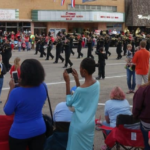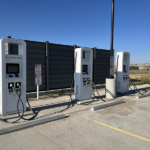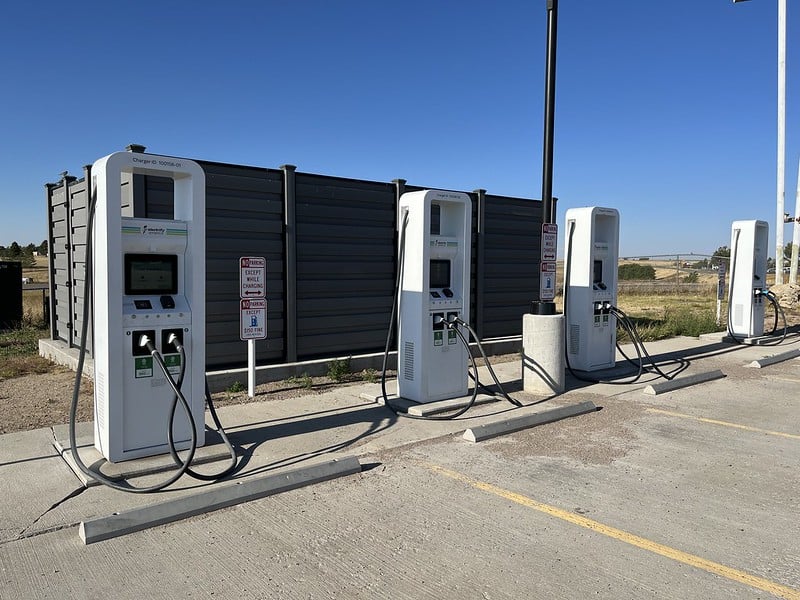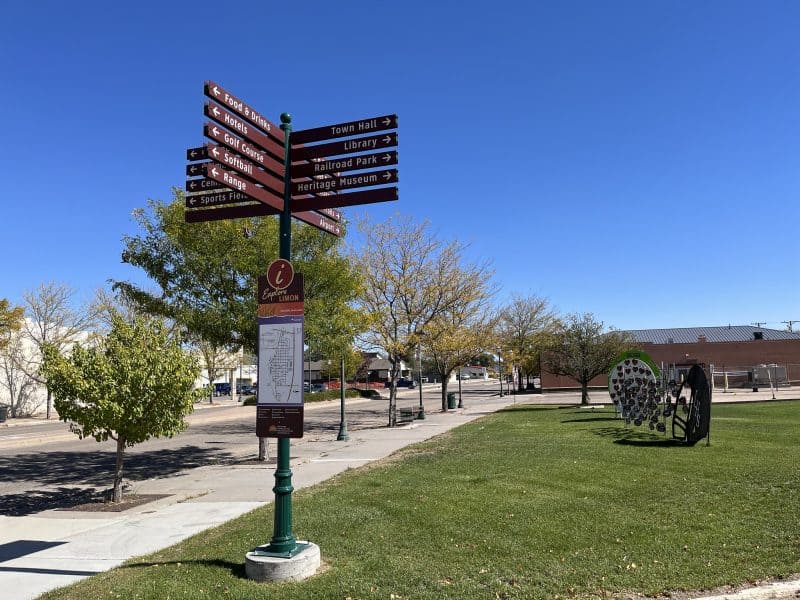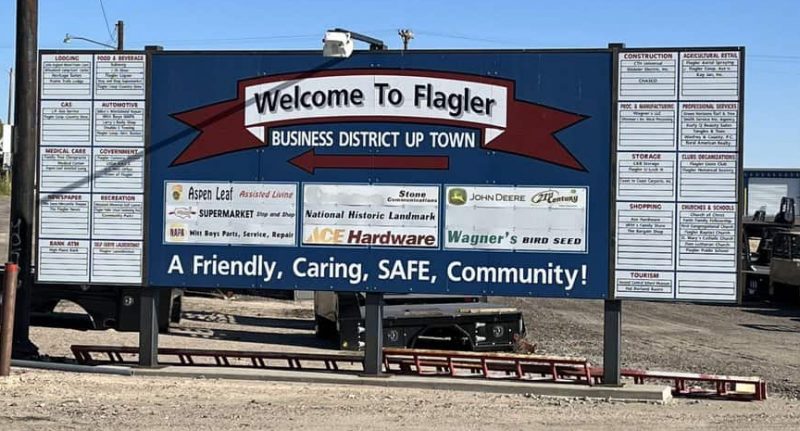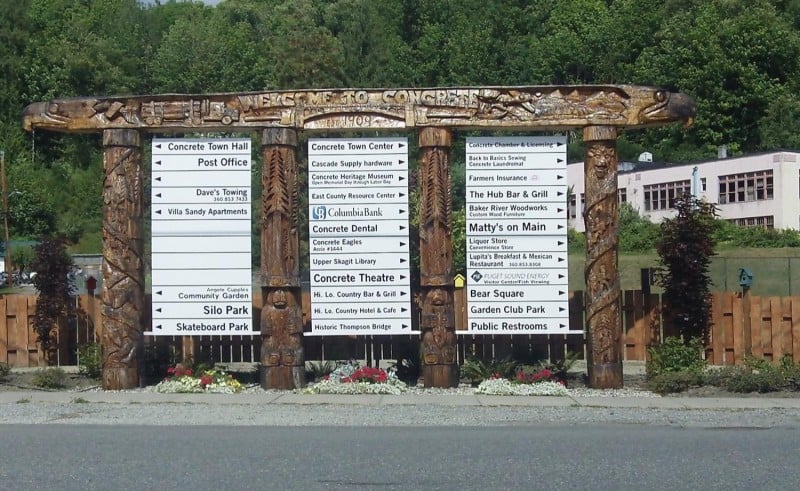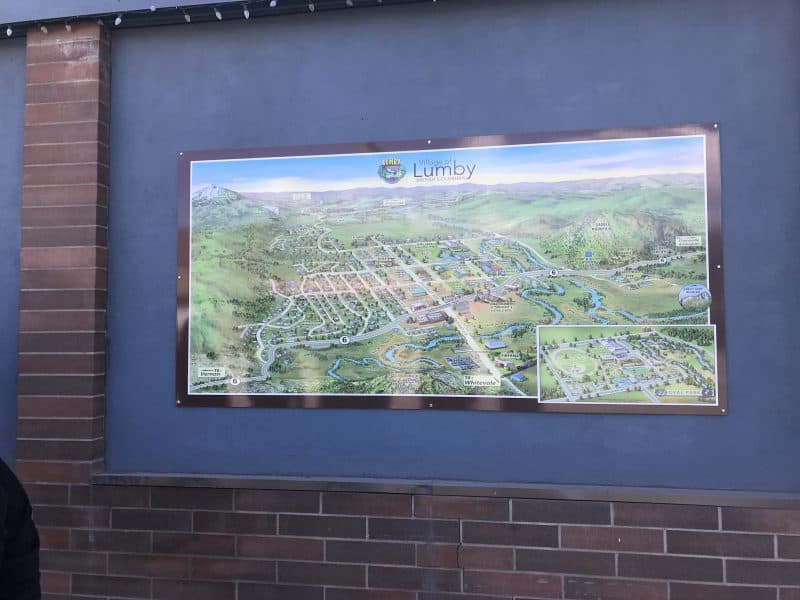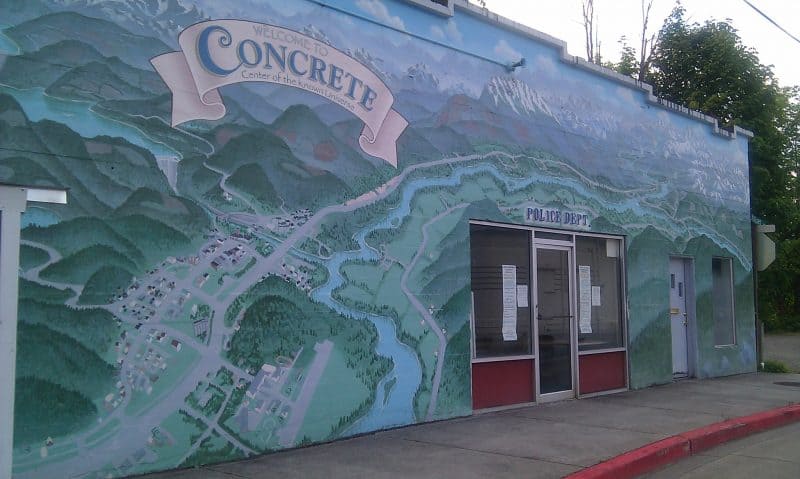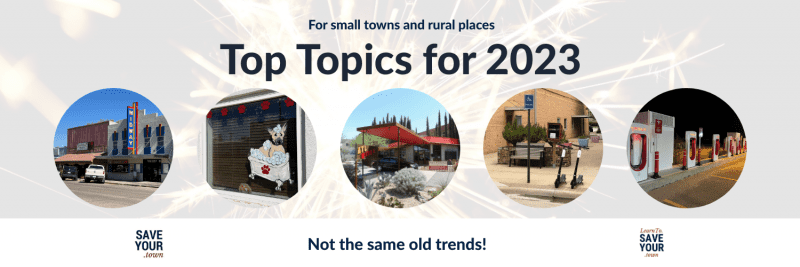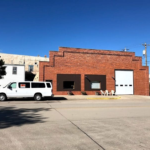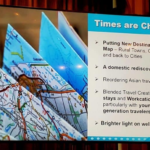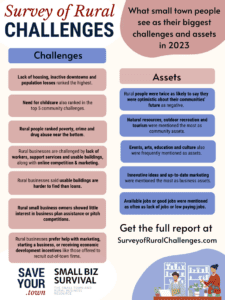Monthly Archives: June 2023
How to start a laundromat in a small town on a budget
Starting a laundromat involves a lot of up front expenses, unless you do it the Idea Friendly Way Lots of small towns have no self-service laundry facilities, so it’s a smart business to start. It also adds a valuable service and amenity to build your community. Laundromats are notoriously expensive to get started, and […]
Starting a laundromat involves a lot of up front expenses, unless you do it the Idea Friendly Way
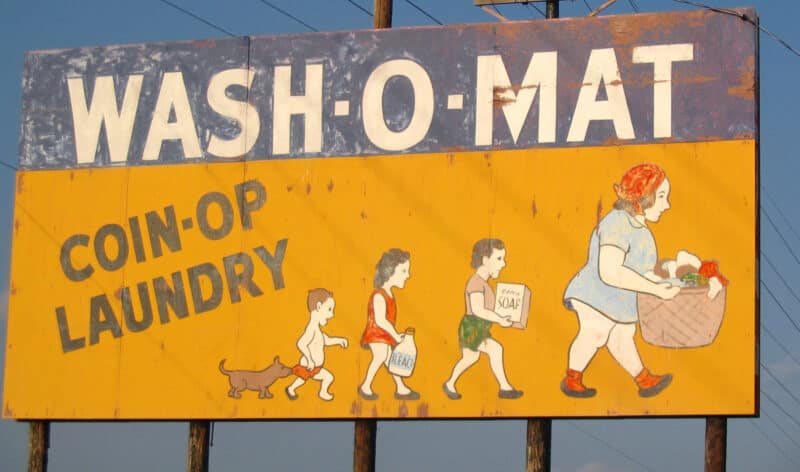
Wash-o-mat sign from the small town of Clovis, New Mexico. CC by chames richalds
Lots of small towns have no self-service laundry facilities, so it’s a smart business to start. It also adds a valuable service and amenity to build your community.
Laundromats are notoriously expensive to get started, and rural businesses have to start with the minimum startup expenses.
The Idea Friendly Method was designed for these small towns and small business realities. An Idea Friendly approach to starting a self-service laundry place in a small town would be to:
Build connections to find what you need without spending any more than you have to at first.
Take small steps and experiment with extra services cheaply to find which ones people use.
Here’s what Building Connections could look like:
- Often, hotels and motels offer a laundry area, maybe just one washer and dryer pair. See if you can build on that.
- Or, ask churches if they have laundry capability and could open it further to the public even during limited hours.
- Deb Brown told me about a Chicago sports bar that offered laundry in the back room.
Ask around for other groups or people in town who might be good partners.
Here are some extra services to experiment with by Taking Small Steps:
- Reader Emily Karsjens Perry mentioned 24 hour vending machines and exercise equipment. (If your Idea Friendly mind went straight to asking around to find donated or thrifted exercise equipment, 5 bonus points!)
- Sheila Scarborough mentioned the combination businesses Frama Coffee at Tumbleweed Laundry formerly in Marfa, TX. (Idea Friendly version: single serve coffee machine?)
- Deb Brown said another laundromat in Thomasville, NC, was near a bingo parlor. Deb said you often saw folks waiting on laundry who would fill their time by crossing the parking lot to play bingo. (Idea Friendly question: could you try a pop-up laundry, maybe in an empty building near an attraction like bingo?)
What ideas would you throw in the wash?
What small town businesses can do during events to capitalize on the extra people
Guest post by Jeremy Zeller Do your homework – WHO WILL BE ATTENDING the event? Cater to that audience. Families, College students, Car enthusiasts, Cosplay…yes, even them. If you do not want to keep your store open, set up a SIDEWALK STAND or TABLE and sell there. An assortment of products and swag to just […]
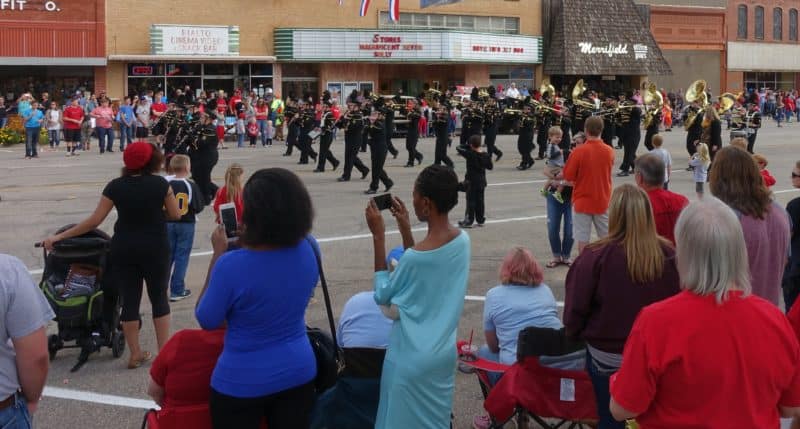
Everyone’s in town for the big event. Is your business ready for them? Photo by Becky McCray
Guest post by Jeremy Zeller
Do your homework – WHO WILL BE ATTENDING the event?
Cater to that audience. Families, College students, Car enthusiasts, Cosplay…yes, even them.
If you do not want to keep your store open, set up a SIDEWALK STAND or TABLE and sell there.
An assortment of products and swag to just give a little taste of what you offer for when they come back.
Bring the right FREEBIES.
This can be as simple as a bag with your logo on it, or a package of tissues with your logo on it. Chapstick, small notepads, microfiber cleaning cloths. It should be something that people use often and keep around either in their purse or car. Be sure to have your logo with the business name and what you are, address, and social media. Phone number is fine, but they are more likely to want to come back to visit or look you up first.
Hold a DEMONSTRATION.
Do you have a product you want to show off? Now is the perfect time to do so. If it is clothing, get a few models to show off your merchandise.
SURVEYS – 5 questions at max that will help your business succeed.
Examples: “How satisfied are you with the customer service you received?” “How satisfied are you with the price of our product/service?”
“What is the most memorable part of your experience?” “Where do you live?”
Collect video TESTIMONIALS or written testimonials.
People love to hear stories. Find customers that you have that can talk about a product they bought, how great it is, and maybe something that happened when they used it. Example: “I bought this Consuela Bag for my Mom on Mother’s Day. The quality is so great because we have used it while camping at Alabaster Caverns to Sand Dunes in Waynoka to visiting the Salt Plains and it still looks brand new!”
While on the topic of videos, get a video ENDORSEMENT. If it is a known official, local or state celebrity, nationally acclaimed, or organization; see if they will give approval to endorse your business and then promote it later.
Share COUPONS or vouchers.
Events a great time to get them to a bunch of people. “10% off” “Free Gift”. Be unique.
Create a SALES EVENT to take place the next day or week.
You have a chance to reach out to many people. So create your own event sometime after. Advertise it during the event taking place.
Create a POKER WALK during the event.
Work with other businesses open during the event. Do a 20% DISCOUNT SHARE. This means if they shop at one store and buy something, they get a 20% discount at another store. That store has it for another store. And so on and so on.
Be an event SPONSOR.
Before the event is happening, see what it takes to get your name on the advertisement.
Gather E-MAILS.
This is the perfect time to build up your client list. Use your phone to collect and store e-mails to increase your customer e-mail blasts.
About the Author
Jeremy Zeller is the Economic Development Director for Woods County, Oklahoma. Previously he worked 16 years for the Oklahoma Department of Commerce including the Main Street program. He holds a degree in film, video and photography from the University of Oklahoma.
Related stories
Rural Tourism Trend: electric vehicle chargers can drive visitors
Electric vehicle chargers are a perfect place for tourism wayfinding signs. EV charging stations are popping up in lots of rural places, especially along interstate highways and along the coasts in the US. They’ve become relatively common at some motels as well. Chargers are also popping up globally in rural places. Deb Brown reported seeing […]
Electric vehicle chargers are a perfect place for tourism wayfinding signs.
EV charging stations are popping up in lots of rural places, especially along interstate highways and along the coasts in the US. They’ve become relatively common at some motels as well.
Chargers are also popping up globally in rural places. Deb Brown reported seeing electric vehicle chargers in rural Portugal in Dec 2022.
This EV charging station is near an interstate highway in Flagler, rural East Central Colorado. Seems kinda boring.
How visitors use electric vehicle charging stations
Most drivers are stopping at chargers for a boost, rather than driving until the battery is empty and charging it to 100%. As Canary Media reported, “EV charging tends to come in sips, rather than gulps.”
How long does EV charging take? Quick chargers take 15 to 30 minutes to deliver this kind of sip.
Imagine people pulling off the highway and into your small town, then standing around or sitting in their cars for 15 to 30 minutes. What could you do to turn them into visitors?
Idea 1. Post wayfinding signs
If you already have way-finding signs for your community, look for EV charging stations to post them at.
Limon, Colorado, has the full wayfinding sign package: directional arrows to all the amenities, plus a map of the town mounted on the post.
Idea 2. Include signs to businesses
What local businesses might a traveler visit? Any kind! Of course retail, convenience, grocery stores and restaurants. But while you’ve got the chance, why not go all out and share a huge business directory sign?
This wayfinding sign is not far from the EV charging station shown at the top of this article. It’s in Flagler, Colorado, and includes an easily-updateable list of businesses and a pointer to the business district.
Idea 3. Feature your local culture
When you pull into Concrete, Washington, from the highway, you come to a stop at the main intersection facing this wayfinding sign with a list of businesses and direction arrows. The chainsaw art border reflects their local mountain culture and history.
Idea 4. Show them a map
This wayfinding map of the town of Lumby, British Columbia, Canada, includes an inset map of the town park. The design is printed on metal and mounted on the building. When it fades, it will be easy to replace.
Idea 5. If signs aren’t allowed, paint a map mural nearby
If wayfinding signs aren’t allowed, how about an artistic map mural? Here Concrete, Washington, lays claim on being the Center of the Known Universe. This mural led me to discover the historic concrete bridge at the edge of town which was well worth a visit for an infrastructure nerd.
Get more top topics for small towns
This is just one of the 5 top topics that Deb Brown and I put together. These topics are ones we think don’t get enough attention right now. Discover the other 4 topics at LearnTo.SaveYour.Town: 5 Top Topics. No charge.
How to get customers in the door of small town and rural retail stores
If you have a retail store in a small town, you know how difficult it can be to attract customers in the door. With so much online competition and limited resources, it is hard to get people in the store and buying your products. In this article, we’ll share some of our best ways […]
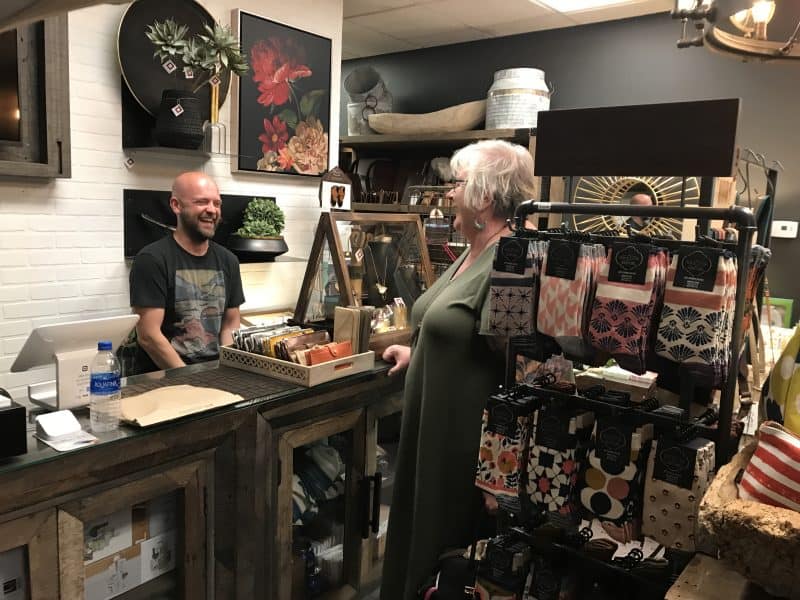
Having trouble getting customers in the door? Consider these tips. Photo by Becky McCray
If you have a retail store in a small town, you know how difficult it can be to attract customers in the door. With so much online competition and limited resources, it is hard to get people in the store and buying your products. In this article, we’ll share some of our best ways to get customers in the door of your retail store.
In our recent Survey of Rural Challenges, one store owner said, “Our challenge is getting customers in the door. They assume the selection and prices will be better at big box stores. If we can get people into the store they see that we have better quality at better prices, and we get the sale.”
Another said even bribery wasn’t working: “People who live in town have never walked through the door. Even when I sent them a $20 gift card to entice them.”
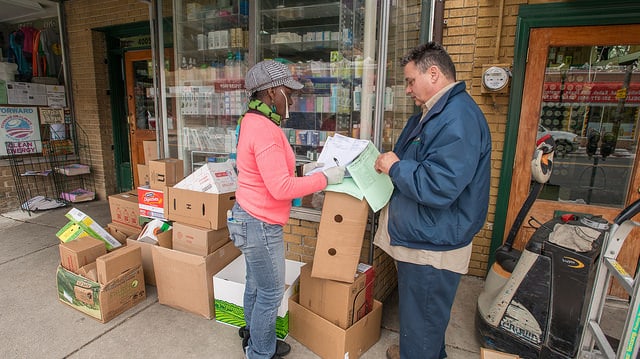
Check your store’s product selection. Is it what people really want these days? Photo by USDA
Do you have what they really want?
Make sure you have what your customers want. All the promotion in the world won’t drive customers to a business that doesn’t offer what people want.
The first retailer above said if customers do come in, “we get the sale.” That’s a good indication that you’re on target.
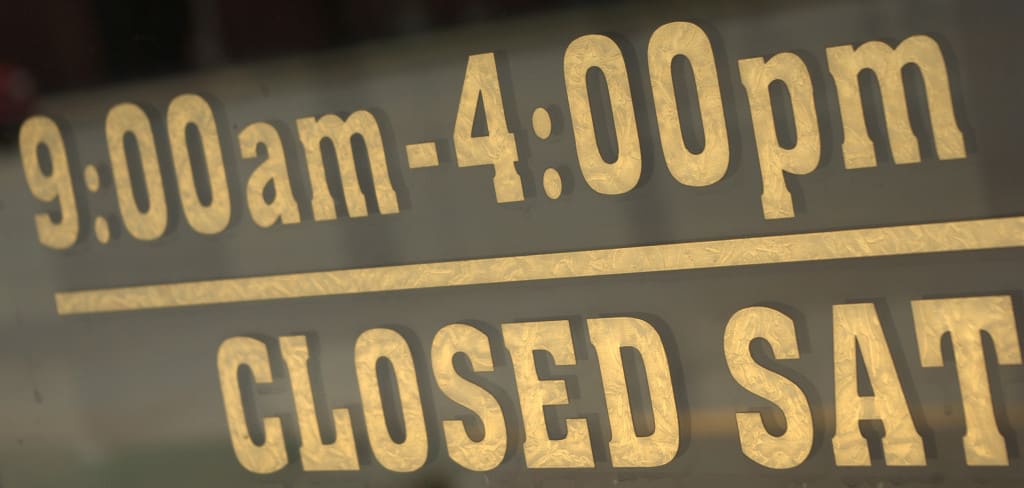
Limited business hours are the Number One complaint against small town businesses. Most of us don’t live on this schedule any more. Photo by Becky McCray.
Are you open when they’re shopping?
They can’t come in the door, if the door isn’t open.
Bob Phibbs, The Retail Doctor, made a house call with us some time ago to talk through small town retail challenges. Here’s his advice about hours:
“Studies have shown that, in order, these are the best money making times for retail:
- Saturday 11 am – 1 pm
- Saturday 3 pm – 5 pm
- Sunday 3 pm – 5 pm
- Sunday 11 am – 1 pm
“If your store is closed on Sundays, you may be missing out on two of the top four money-making times! You have to test these against your store to see if it proves true.”
I ran a retail store for almost 13 years in a small town. We were open 10am to 9pm, Monday through Saturday. Sales from 5-9pm were always more than sales from 10am to 5pm. Almost every single day for over 4000 days, evenings beat day time for us.
If you’re willing to do some simple research, you can find out the best hours for a store in your town.

You have a lot of marketing tools at hand today. Use them to remind people over and over that your store is here and what you offer.
Invite them in again and again, at least 13 times
Our contributor Glenn Muske said, “Research has found that potential customers need to hear or see the name of a new business three to five times before they even recognize that the business exists. Thus, a one-time big advertisement will do little to bring in customers. Continuity in the early days is crucial.
“Knowing about the business is only part of step one, however. You now have to get customers in the door. Research suggests that potential customers may need another five to seven contacts with your product or service to recognize its benefits to them. Remember, the customer wants to solve a problem.”
Contacts with your customers can be all the times they see your ads, social media posts, flyers, online listings, signs or sponsorship of local causes. You don’t get to count the ones they don’t see.
You have to put your business out there a lot more than you think in order to get just one customer in the door.
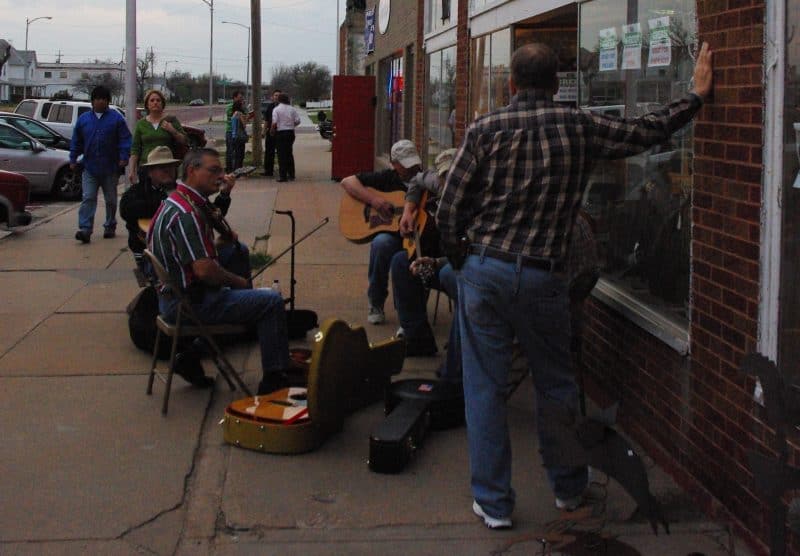
Musicians on the sidewalk? Tool days in the parking lot? Dinner in the greenhouse? There’s no end to the experiences you can create in or outside your store that help you bring people in the doors. Photo by Becky McCray.
Create experiences with events
To survive in independent local retail today, you must provide an experience that can’t be duplicated by chain stores or online or in the big city. Events are one of the best ways to create a meaningful experience that is tough for any big store to duplicate.
Hold an event that is a real experience
The owner of a retail hardware store and greenhouse in rural Kansas started brainstorming ideas for events he could hold to create an experience for customers.
- Tool Days. Bring in the guy who does blade sharpening for the afternoon. Set up tents in the parking lot and have people teach how you use tools of all kinds. Do demonstrations and hands-on (appropriate) play with tools.
- Dinner in the Greenhouse. His well-stocked greenhouse is a wonderfully green and lush space in dry Western Kansas. There’s room for a couple of tables, and there’s a bubbling fountain. It’s great! Let’s have dinner there! Get a local eatery or aspiring chef to cater. Have fun with it. Use a jungle theme. Get creative. Since there are only a couple of tables available, turn it into a super-exclusive special thing that not everyone can do. Sell out early.
Do a bunch of mini-events
I’ve shared these ideas for mini-events for rural retail businesses before:
- Recruit anyone who gives lessons to hold a student performance (could be music, dance, martial arts, drama, writing, language, anything!) Students bring families, instant crowd
- Bring games, tables and chairs and hold a game night (board games, card games, dominoes, adult coloring books, you name it)
- Bring beach chairs and umbrellas and pretend you have a downtown beach (play beachy summer music for bonus points)
- Hold a tasting or sampling from any local winery, food business, or even cooking classes
- Read poetry or start community conversations on any topic you like (poetry slam?)

A local furniture store hosts two temporary businesses for a special shopping event, combining business-in-a-business and pop-ups to benefit everyone. Photo by Becky McCray.
Host a pop-up business inside your business
Invite another business to set up in a corner of your shop, as a pop up. This could be an artist, artisan, maker, crafter or tinkerer.
Look for those that are doing business from their homes. Maybe they are just beginning to think about making some money with their products or are just starting to get an online following.
Once they setup, make more of it:
- Hold a meet the artist event
- Have a party announcing your new acquisition
- Create a Facebook event and do something special to announce their arrival
Joann Schissel shared her pop-up event success story with me:
“My partner and I have a winery business (Nearwood Winery). He makes the wine, and I’m in charge of customer experience. We have a small tasting room on the square in Knoxville. We’ve found that pop-up shops or a one-time event seems to bring in customers. Our next community event is “Living Windows” which kicks off the holiday shopping season. We invited a crafter to set up her “shop” inside our wine tasting room for that evening. She sells hand made gift bags that hold a bottle of wine. Other pop ups we’ve had is book signings by local authors and art exhibits by local artists. All these type of promos seem to bring in customers. We try to focus on products/services that enhance the wine experience. Our motto is “where creatives gather.”
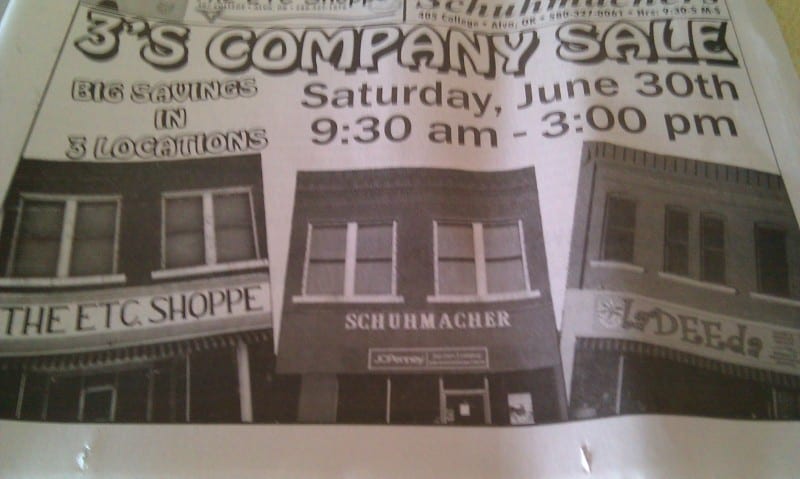
Three local stores cooperated on this joint ad, marketing their stores together. Photo by Becky McCray.
Cooperate with other businesses
Leverage your relationships with other businesses to put together a tour of businesses, or an experience that includes more than just your business.
Joann did this, too! She created a local fashion show:
“I reached out to our business owners that had fashions or a tangent business. I know a jewelry designer that will match her product with the clothes from the boutiques. A local photographer will take photos of the models and the event. A fabric designer that makes her own jackets will model her creations.
“I charged $5 advance tickets (available online or at the shops) and $10 at the door. The first beverage is free, so there is very little ‘risk’ to the guests, but allows me to gauge interest and attendance. We had 15 models (includes kids) and friends/relatives were in the audience. I am focused on ‘gathering my crowd’ strategy and catering to established groups of people that have their own crowd. I loved working with the women business owners and promoting their products.”

The retail store owner’s dream: so many customers, they can’t all get in the doors at once! Photo by Becky McCray
Keep trying and keep trying
After more than a dozen years of small town retail experience, I understand how it feels to stand in an empty store and wonder where all the customers went. But today, we have so many tools to market our businesses, serve customers in new ways, and create experiences they can’t get anywhere else. Our best bet for survival is to keep trying new experiments and keep the ones that work best. Then try more new experiments.
Using a building as a warehouse or storage in a small town? Put up a sign
Repurposing empty buildings as business storage or a warehouse is a common small business practice in small towns. Putting up a sign is a good idea for at least two reasons. Retail businesses may be storing extra merchandise. Manufacturers might have extra materials or finished product ready to ship. Service and repair companies have to […]
Repurposing empty buildings as business storage or a warehouse is a common small business practice in small towns. Putting up a sign is a good idea for at least two reasons.
Retail businesses may be storing extra merchandise. Manufacturers might have extra materials or finished product ready to ship. Service and repair companies have to store parts and accessories somewhere.
A sign makes your town look better
If there’s no sign, people will assume it’s an empty building or full of someone’s junk. If there’s a sign, it’s a business. That’s just natural.
And doesn’t an active business building seem better than yet another empty building? Rural expert Deb Brown pointed this out to me, and I agree. Here’s an example building she found. It’s clean and well-maintained, but there’s no sign! It might be someone’s muscle car collection, or a social club, or a local manufacturer. We just don’t know! (And we probably assume the worst.)
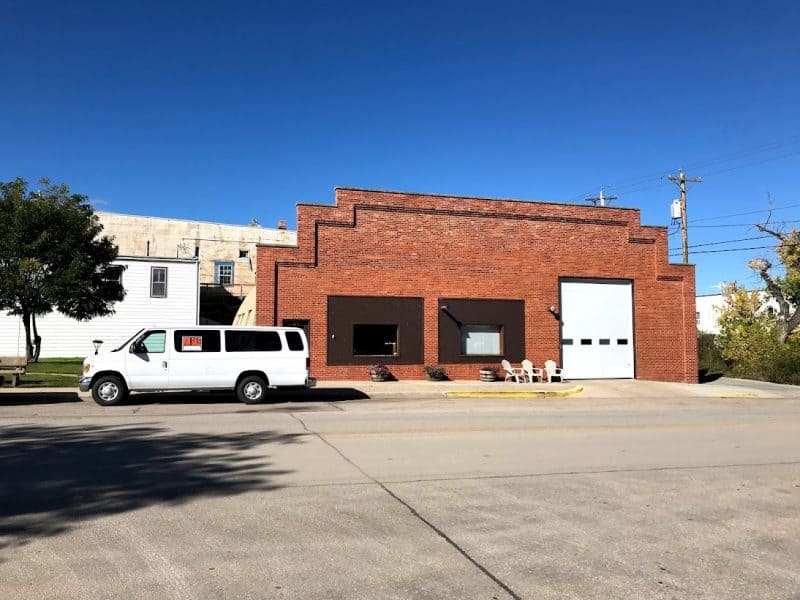
Photo by Deb Brown
Before you tell me everyone in town knows, remember that other people drive by. People visiting town have no idea whether it’s junk or an active business. That might include people considering moving to town or businesses considering your community.
Put up a sign on your warehouse and storage buildings, and you’re contributing to a town that looks more active and prosperous. That’s good economic and community development.
It might deter thieves
My first thought about putting up a sign was that it might make your business a target for theft. So I asked someone who has some insight into the thought process of people who break into rural buildings.
Your local thieves already know what’s in there. Adding a sign does not change that. (Hint: Didn’t you just tell me everyone in town knows?)
Thieves are more likely to look for buildings that don’t get a lot of traffic. If there are weeds growing up and not many tracks and no sign, that looks like a better target.
Here’s an example I saw. It’s not as well maintained, but clearly in somewhat current use. The old faded sign could be replaced with something new that mentions the local business that uses this building. And a little paint on the door and trim wouldn’t hurt either.
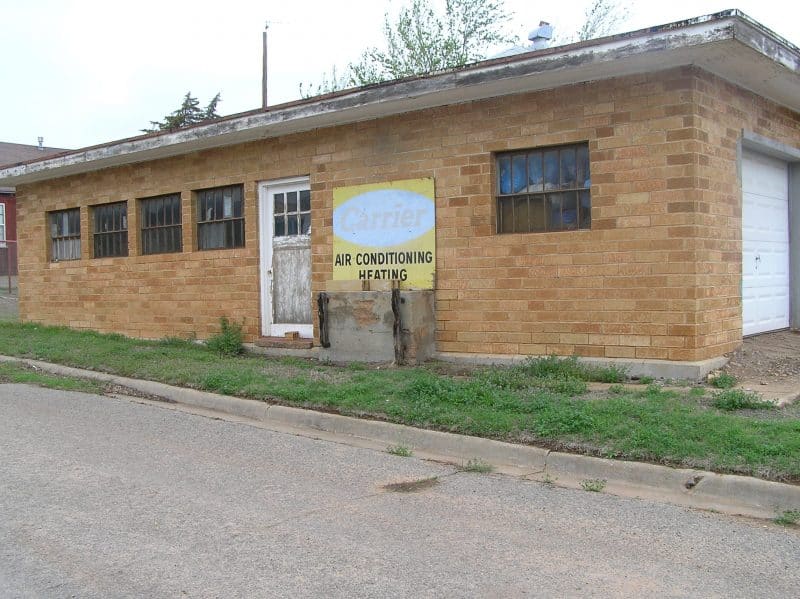
Photo by Becky McCray
Adding a sign makes it look more like you’re there often, so that makes it slightly less attractive as a theft target. Will a sign stop all break ins? Of course not.
Bonus points: Make a window display
Billy Cook Harness and Classic Saddles in Sulphur, Oklahoma, uses a repurposed downtown building for warehouse and shipping. They’ve put a display of saddles and the templates used to make them in the window along with a sign. You can see by the pile of boxes that I came by right before the shipper picked up for the day.
This window display and sign makes the building and downtown look much better than just another empty building used for storage of who knows what.
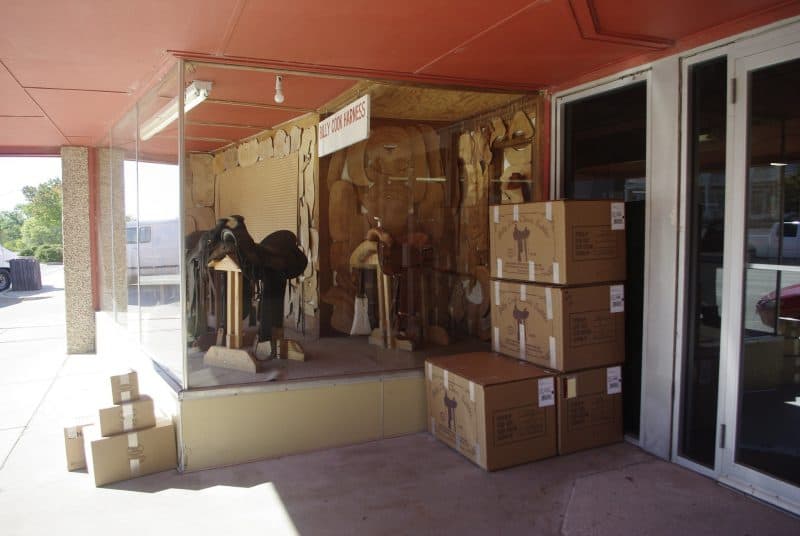
Photo by Becky McCray
Subscribe to Small Biz Survival
Send us your small town business stories, and let us know what questions you have.
Move Your Money and Bank Local
April is traditionally Move Your Money Month in the shop local community. Bank Local and Invest Local are the financial parts of the shop local movement. In 2023, the timing couldn’t be more noticeable. High profile bank failures, lots of talk about other banks in trouble, and a serious debate about the financial system (AGAIN!) […]
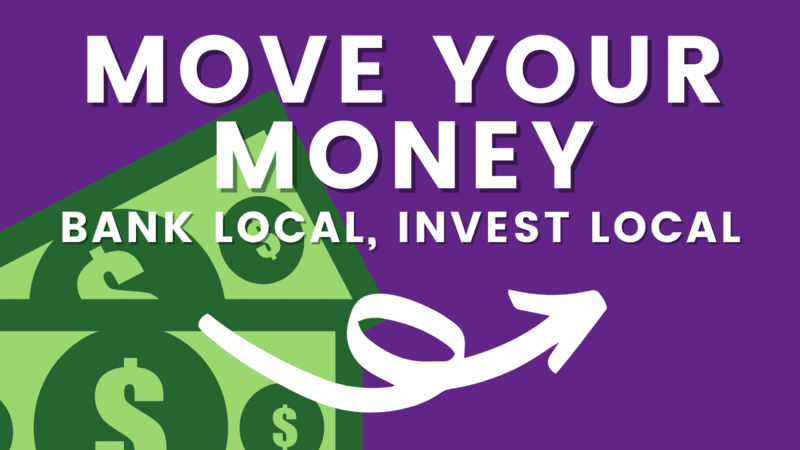
April is traditionally Move Your Money Month in the shop local community. Bank Local and Invest Local are the financial parts of the shop local movement.
In 2023, the timing couldn’t be more noticeable. High profile bank failures, lots of talk about other banks in trouble, and a serious debate about the financial system (AGAIN!) make Moving Your Money to a local bank more attractive than ever.
Local banks still exist in many small towns, and some of you have multiple local bank choices. If you don’t have a locally owned bank, regional banks may be a better bet than the giant banks.
If you have concerns, talk to your local or regional bankers. Some like Jill Castilla of Citizens Bank in Edmond, Oklahoma, (admittedly in a suburb, but still a great role model) go to great lengths to be accessible to their community.
Find your bankers online or at community events. Ask questions about how they manage the kind of risks that brought down big banks recently. See what you think of the answers. (Hint: they’re much more careful.)
Move Your Money
Really, it’s not that hard to move your money to a local bank. You’ll likely get all the important services you’ve come to rely on like mobile deposit and online bill pay. Even the bank in my tiny community of 30 people is online-savvy. (Shout out to Hopeton State Bank: Shaped by the past, Focused on the future.)
Need the how-to-move list? Search or ask your favorite AI for a list of steps to move to a new bank.
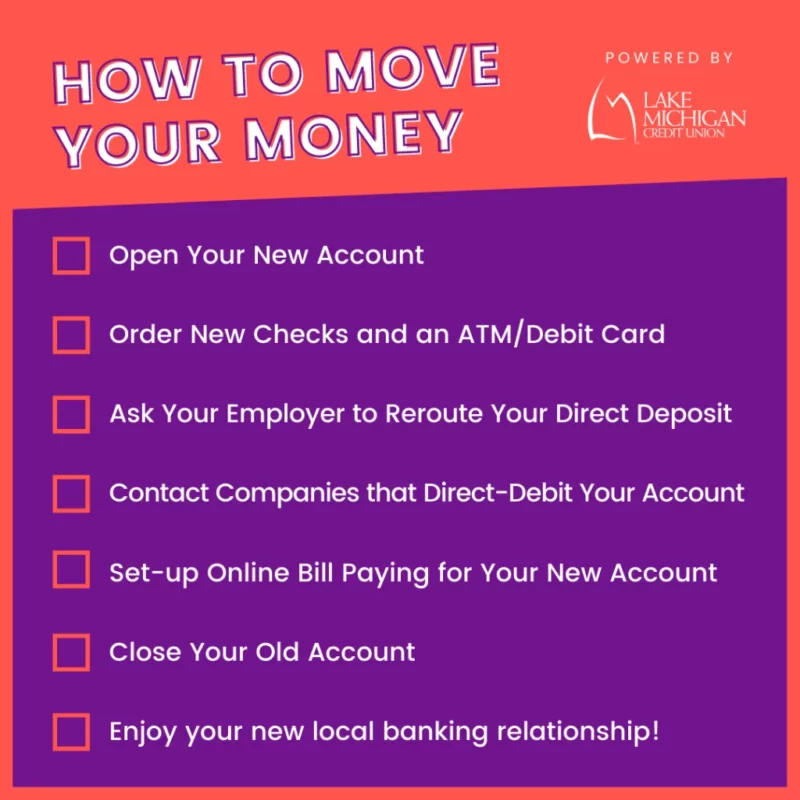
Source: People First Economy
Run a Move Your Money campaign in your community
Join the Move Your Money movement at AMIBA (American Independent Business Alliance). They’ll email you with resources throughout April. Check the Top 5 Reasons to Choose a Community Bank.
Get inspired by the resources page from The Local Crowd in Monadnock, NH: Move Your Money
Advocate for change with the policy-level info from the ILSR on Community Banking.
Discover more about local banking and local investing
Beyond shop local is bank local, 2010
Local investing could solve several rural business problems, 2011
Local investing will change the face of small towns, 2012
Small Town banks know lots that big banks don’t, Small Town Rules, 2013
Community banking is critical to small towns, audio, more from Jill Castilla (mentioned above), 2014
Economic self defense for small towns, 2020
Subscribe to Small Biz Survival
Will you run a Move Your Money campaign? Send us your small town business stories, and let us know what questions you have.
Rural tourism trends say small towns are still cool
But you already knew that Tourism Currents, experts on social media for tourism, wrote about 5 travel trends to blog about right now, and there’s a lot for rural communities to latch onto there. 1) Wellness Travel Sheila says, “where people can go to relax, detox, relieve stress, get a massage and spa treatments, eat […]
But you already knew that
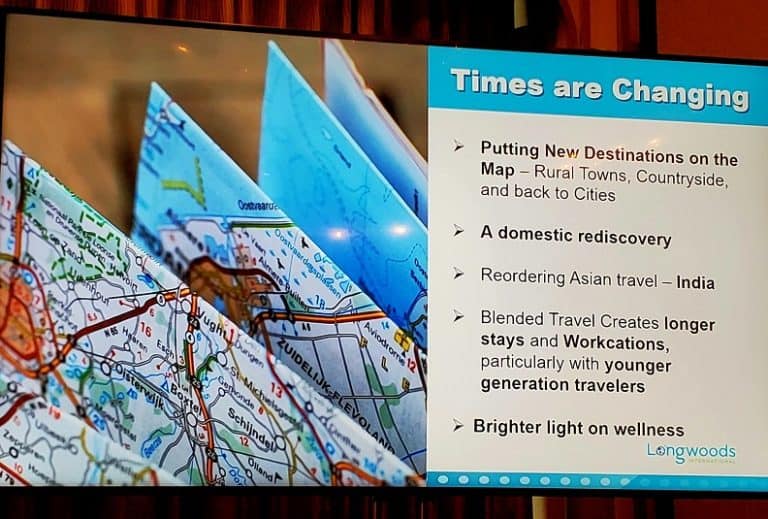
Some possible travel trends to blog about via Longwoods International, on a slide during the IITA (International Inbound Travel Association) annual conference in San Diego, California. Photo by Sheila Scarborough.
Tourism Currents, experts on social media for tourism, wrote about 5 travel trends to blog about right now, and there’s a lot for rural communities to latch onto there.
1) Wellness Travel
Sheila says, “where people can go to relax, detox, relieve stress, get a massage and spa treatments, eat healthy food, be more mindful, get some exercise, etc.”
You can promote your clean air and water, and even your small town slow pace of life is part of wellness.
2) Sustainable, Eco-Friendly Travel
Some of the keyword trends include:
- Greener, more local getaways
- Environmentally-friendly travel ideas
- Eco-friendly, eco-conscious vacations
3) Multigenerational and Family Travel
Sheila said there has been a spike in searches for “where to plan a family reunion.” This is a great chance to feature how safe your town is for kids, how many activities are open to everyone in the family.
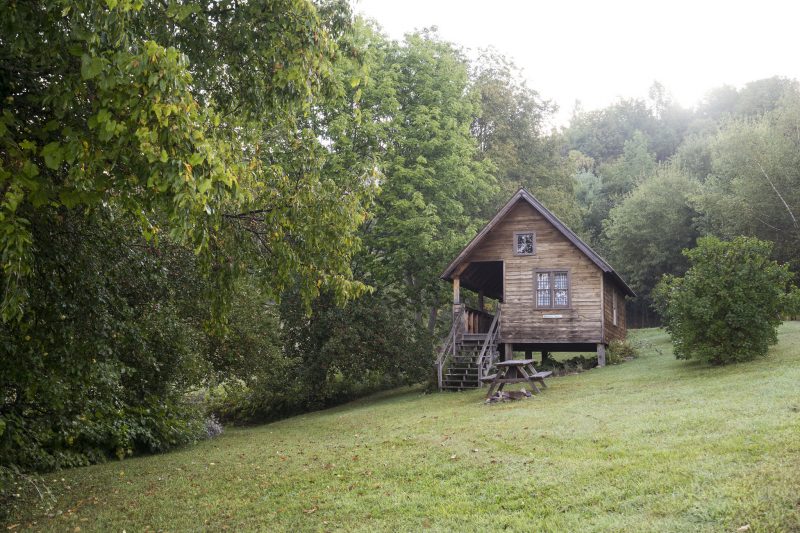
A rural cabin rented via HipCamp. Photo CC by Myles Tan
4) An Appreciation for Nature & The Outdoors
“Smaller towns, rural areas, scenic byways – they all have an advantage right now, in that travelers still very much want the natural beauty they can offer,” Sheila said.
Hello, nature! See our pair of articles on Harvest Host, Boondockers Welcome and also HipCamp.
5) Unique, Local Experiences
Sheila said travelers want to “Learn about and support local culture. Do something hands-on, like a cooking or craft class, that teaches you about that local culture.”
Look to your local artists, crafters, musicians, makers and other fun creatives. Do they offer short term or one-day classes? Are there longer retreats in your area? All these are smart things to share about your community.
Is this just a fad? No.
“There has been a big uprise in traveling to smaller towns that have some quirky and regional appeal,” said Arabella Bowen, executive editorial director of Fodor’s Travel. “There is a want for a local, authentic, mom-and-pop experience.”
That’s from 2013. And it could just as well be from 2023.
All the themes from 2013’s Changing travel motivations favor small towns are still true. People want to explore, visit local artists, and get off the beaten path.
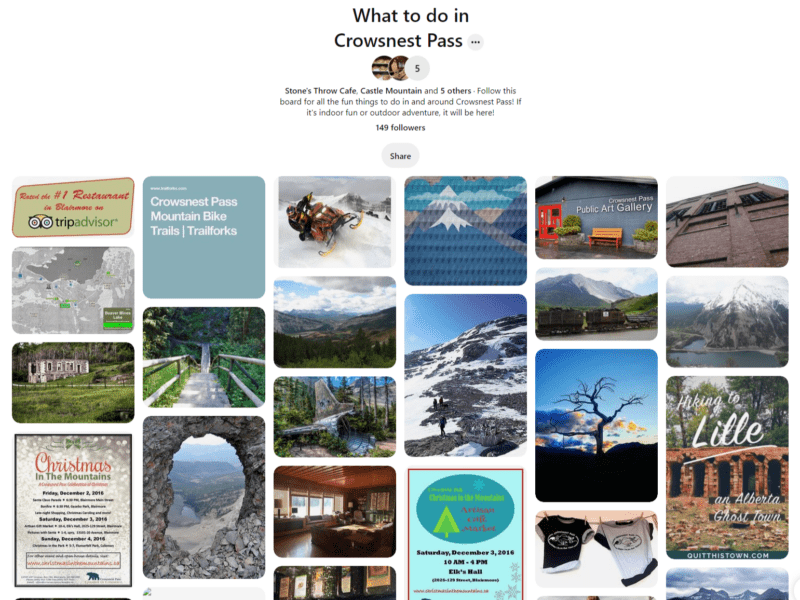
Make your “What to do in…” Pinterest Board today!
What to do: action steps
Of course blog about any of these topics, as Sheila suggests.
Share anything from your town that fits into these trends on your social channels.
Promote these destinations on your “What to do in [town]” Pinterest board. We’ve said it before, but this is still a great tip!
Play up your quirky businesses, mention your local characters, and share the things that some folks find embarrassing but that make your town unique.
Full disclosure: I helped co-found Tourism Currents along with Sheila Scarborough.
Local leaders: Start with intuition about your community then add data
How do decisions about your town’s future get made? Do government officials and volunteer leaders rely on what they already know, or do they rely on data generated by outside experts? Or might it be both? By Paula Jensen Intuitive decision making is based on gut feelings, past experiences, and personal judgment. It involves using […]
How do decisions about your town’s future get made? Do government officials and volunteer leaders rely on what they already know, or do they rely on data generated by outside experts? Or might it be both?
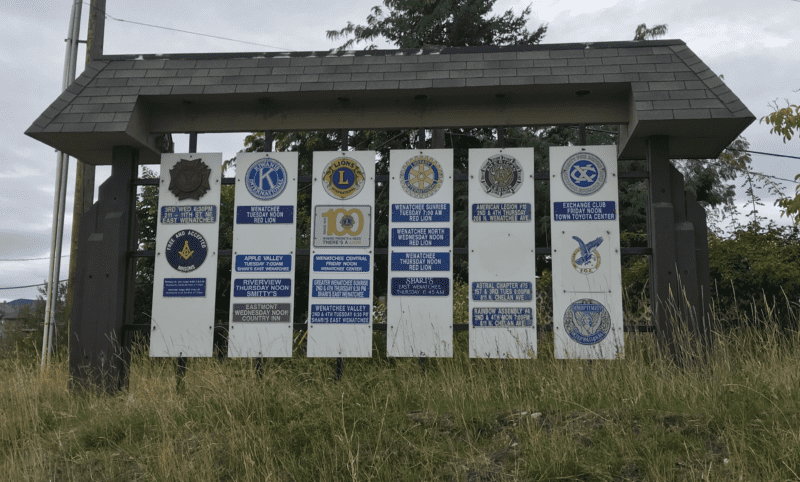
By Paula Jensen
Intuitive decision making is based on gut feelings, past experiences, and personal judgment. It involves using our instincts and emotions to decide, without relying heavily on data and analysis.
Data-driven decision making is based on objective data and analysis. It involves collecting and analyzing relevant data to identify patterns, trends, and insights, which are then used to make informed decisions.
Let me share a small-town leadership story.
About three years ago, I was in a board meeting with an economic development organization discussing their need to attract workforce for about 90 local job openings. The economic development director shared a couple recent stories about how limited housing stock was a big barrier for attracting more workforce. After a short discussion, one of the board members stated firmly, “I’m a realtor. We do NOT have a housing problem! There are currently twelve homes for sale and multiple apartment vacancies.” At that point, the conversation stopped.
Both people were accurate in their reports, yet in hindsight what was missing from the conversation was some quality secondary data available from their local housing study. The Housing Study, completed by a third-party, stated:
“The community has a stock of older, lower valued homes, of which 59% need minor or major repairs and another 3% are dilapidated. Our analysis of sales activity indicates that approximately 50% of the homes are valued less than $75,750. As some lower valued homes come up for sale, they may not be attractive options for potential home buyers because of the amount of repair work that is required.” In addition, the housing study recommended, “approximately 10 to 15 additional rental units will be needed over the next five years to replace lost units. This replacement is appropriate due to the deteriorating condition of older, substandard rental housing that should be removed from the occupied stock.”
Data can open conversation to new possibilities
In the story above, the economic development director’s intuition was indicating that housing was a strong barrier to workforce attraction. But imagine if that intuition had been backed up with the data from the housing study? That data could have opened the conversation about quality housing being the issue, not the number available units.
I am happy to report, three years after this initial conversation the economic development organization is using intuition (knowing their community) and data (their updated housing study) to move toward solutions that will ultimately address the housing quality issue and attract workforce.
Combining the two approaches of intuitive and data-driven decision making can be very powerful. Intuition can provide a valuable starting point, helping decision makers to identify potential options and narrow down choices. Data analysis can then be used to validate and support these options, providing objective evidence to back up intuitive decisions.
By uncovering the story told by the data, it can also help us see patterns, understand the meaning behind the data, and become more proactive rather than being reactionary to issues as they pop up.
Ultimately, the best approach will depend on the specific situation and the decision being made. In some cases, intuition may be more important, while in others, data may be the key factor. The most effective decision makers can balance both approaches, using intuition to guide them, and data to validate and support their decisions.
Rural and small town ideas from the OU Placemaking Conference IQC 2023
Recently I attended the OU (University of Oklahoma) Institute for Quality Communities (IQC) Placemaking Conference This was the 10th annual event. There were 600 people attending from 40 counties in Oklahoma and 6 surrounding states. I attended the 2017 event along with my colleague Deb Brown. The focus was inevitably on big cities, but I […]
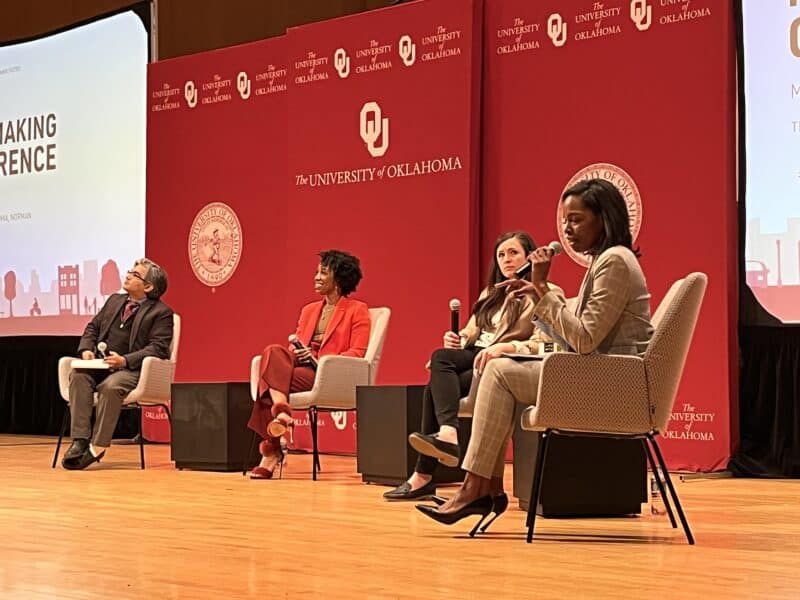
Vanessa Morrison (holding mic) moderates a panel of the ecosystem of communities with (left to right) Mukul Malhorta, Kia Weatherspoon, and Allison Quinlan.
Recently I attended the OU (University of Oklahoma) Institute for Quality Communities (IQC) Placemaking Conference
This was the 10th annual event. There were 600 people attending from 40 counties in Oklahoma and 6 surrounding states.
I attended the 2017 event along with my colleague Deb Brown. The focus was inevitably on big cities, but I was there scouting for rural and small community ideas we could all use.
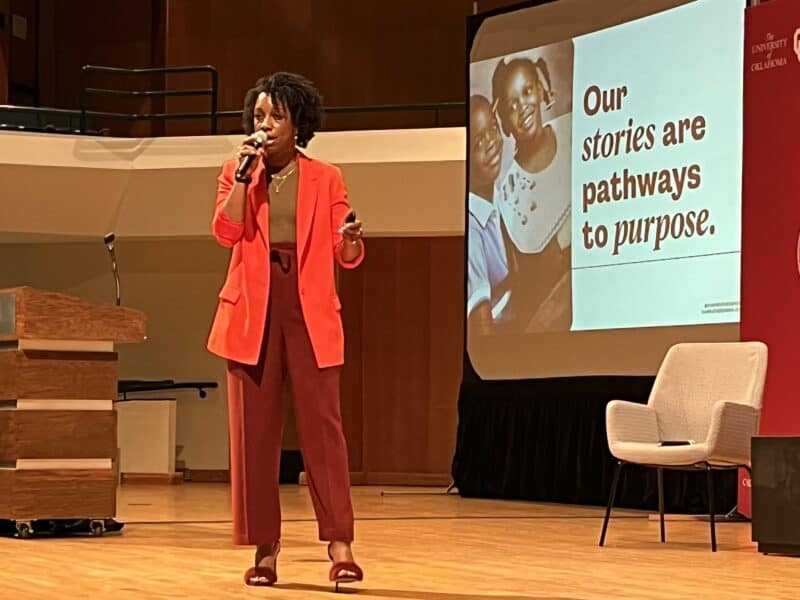
Kia Weatherspoon, President, Determined by Design, shared how her personal stories were her pathway to purpose.
Purpose Driven Path to Design Equity
Kia Weatherspoon, President, Determined by Design (interior design)
Kia shared how she came to work in interior design. Visiting her brother in prison, she found walking into the building and the entire environment to be dehumanizing. Later she served in the Air National Guard with three tours in Iraq. She improvised a space by hanging up sheets so she could feel safe dealing with the overwhelming emotions of war.
Those experiences–war and prison–brought her to understand how space hurts or heals people.
She works on affordable housing and other projects that normally don’t receive much if any purposeful interior design.
Her first project was for a domestic violence shelter for women. While some initially told her they didn’t need a well designed space because they had other needs to spend that money on, Kia persisted. Once it was finished, one of the women said to her, “When I walked into this space, I realized that change was possible for me.”
“The people who most need design don’t know they don’t have it, and they have no advocate,” Kia said.
- That resonated with me as rural people have little access to the kind of design that can make a difference in their lives, don’t know they don’t have it, and they have no advocate.
Kia said she digs deeply into the stories of the place starting with the land and the Indigenous people of the area. As she moves through the history of the place, she continues to collect stories and images to incorporate into her designs. She uses the phrase “Conjuring ripe heirlooms” to describe what they are creating.
Because these projects usually benefit people with low incomes, sometimes others will push back on her design choices. “You’re making it too nice for these people.” Kia said she sees it differently, asking herself “Is this good enough for my grandmother, my brother, my friend?”
“The spaces that we create today will affect four generations of people,” Kia said.
- That really hit me, as I don’t remember any design discussions in small towns that said out loud that these decisions will affect four generations (or more) in our community.
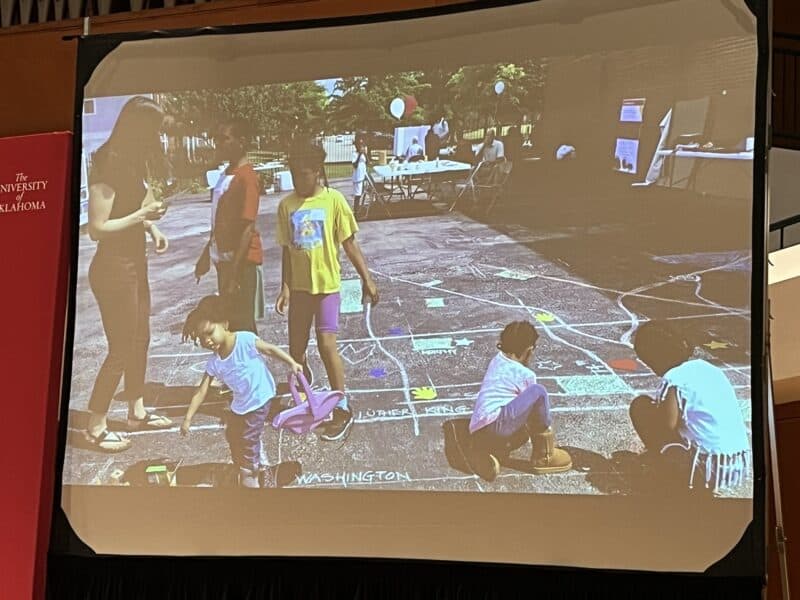
Mukul Malhotra showed this slide of children interacting with a map of their community. “Steal ideas from kids,” he said.
Neighborhoods and Streets for Exchange and Connection
Mukul Malhotra, Principal and Director of Urban Design, MIG, Inc.
Mukul shared stories of street designs and how they affect people and neighborhoods.
Mukul said when you design a street, don’t design it in a room. Go to the street and the people. Get design ideas from kids; they have great ideas. And test your designs before implementing them.
“As designers we don’t always know what will work,” Mukul said.
“But it looks great on a map!” is no excuse for a poor design. Spend more time on building crosswalks than sidewalks. Curbs prevent flexible uses, he said.
One of the most excluded activities is play, he said. The other is mobility.
Mukul also talked about placekeeping, not just placemaking. Many vibrant urban neighborhoods have been lost to big infrastructure projects.
- There is definitely a parallel to our small towns and what we’ve lost due to disinvestment and lack of investment through the decades.
People create places, Mukul said. Give us a reason to be there.
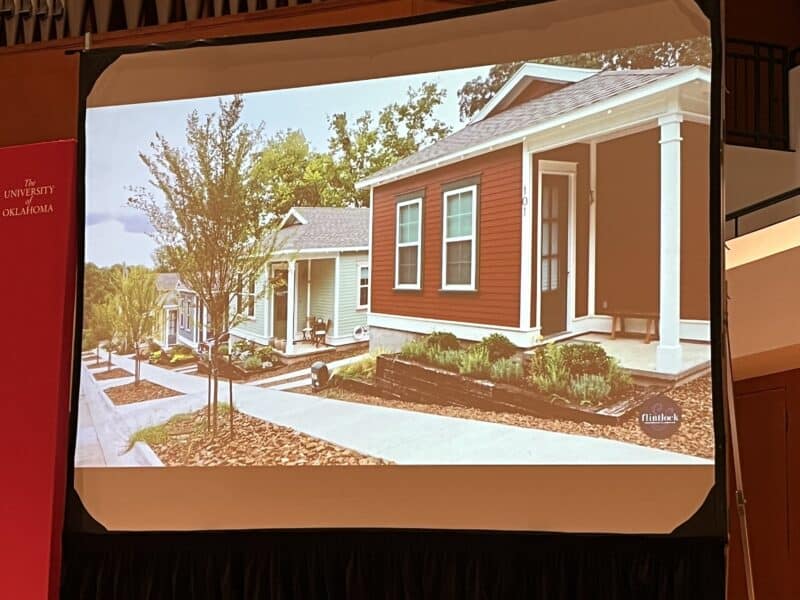
These one bedroom cottages had to be carefully created to meet code, comply with mortgage rules, and fit into the site.
The Power of Cute: Lovable Incremental Community Development
Allison Thurmond Quinlan, Principal of Flintlock Labs, Fayetteville, Arkansas
The product the market needs is not the product the market knows how to produce, Allison said.
As household size shrinks, we need twice as many housing units to house the same population.
1 and 2 person households are the majority of all households, but that’s not the kind of houses we have. There are more 5 bedroom houses in America than 1 bedroom, she said.
Alison said they build small and loveable housing. Loveable efficiency, they call it. Build for people.
Make things cute AF, she said.
Allison shared her design for South Street Cottages and other small scale housing.
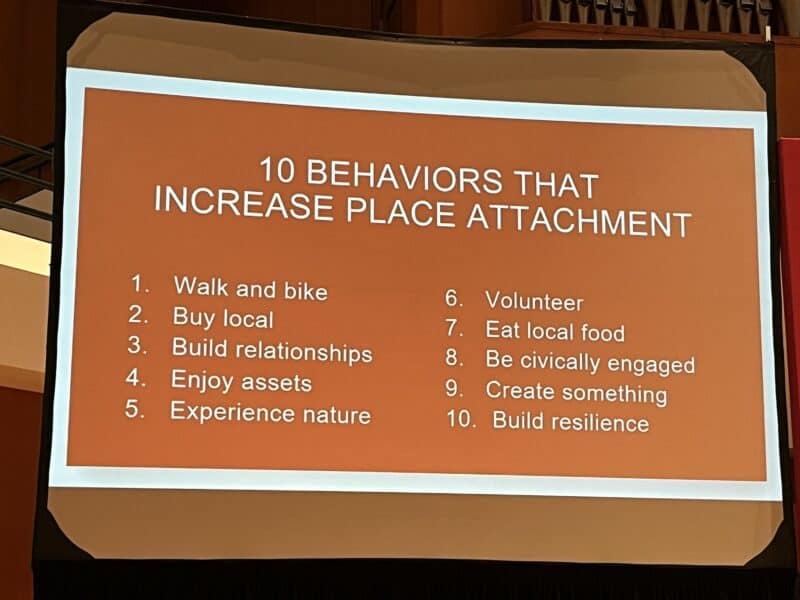
Melody Warnick says you can increase how attached you feel to your place through simple experiences.
The Daily Practice of Loving Where You Live: How to Create Joy in Our Imperfect Places
Melody Warnick, Author, This is Where You Belong and If You Could Live Anywhere
Rooted people feel like they want to be where they live, Melody said. That feeling changes, and it takes about 5 years from arriving in a place for your attachment to peak.
Being excluded is interpreted as physical pain by the brain, Melody said.
Even if you’re a 10 on place attachment, someone else in town is a 1 or 0, she said.
Walking and biking gives you mental maps and that gives you a sense of ownership and involvement, Melody said.
Anyone can choose to do things that will help them feel more attached to their place and a stronger sense of belonging in their community, Melody said.
Just getting a lot of people in the same place makes a community feel vibrant. Make love visible in your community, she said.
I’ve followed Melody online for many years. I highly recommend both of her books.
Our Greatest Source of Joy and Happiness are the Vibrant, Walkable Public Spaces Around Us
Arti Harchekar, Founding Principal, JoyfulUrbanist.com
Arti said we naturally tend to react more to negative experiences. If we can create consistent happiness stimulation, we can rewire the brain to better experience the positive.
Sharing her own struggle with depression, she said third places give flexible levels of interaction to people. Even a quick exchange of “hi” and “thanks” at the local store can be supportive when it’s needed.
Order reduces our anxiety, and an organized cityscape or townscape counts. In a vibrant downtown street, you are being hugged by the environment, she said.
Where the building meets the street, what does it gift to the community? For example, a porch is a gift of being available to connect.
- I thought this was a great way to look at buildings. What gifts do they give us?
Background buildings are the givers of the local environment. They give to the whole community, Arti said. Landmark buildings stand out. You can’t have every building be a landmark or they lose what makes them special.
Put the pedestrian in the middle of the space, and they set the pace for the area.
What percentage of your town’s built environment is the streets? That’s a great question from Arti for cities, but also for small towns. We have a lot of our community in streets.
And still we love this place
Ronald H. Frantz is Director of Small Town Studios at OU Institute for Quality Communities. His previous work at Oklahoma Main Street introduced him to small towns all across the state. While introducing the panel discussion with Melody and Arti, Ron listed off a number of horrible yet true quality of life stats for Oklahoma.
“We’re last in quality of life,” Ron said.
Cheryl Lawson of Tulsa turned to me and added, “and still we love this place.”
- There’s a lot to think about in this exchange. We can acknowledge that our quality of life isn’t great. We don’t benefit from great design, and we don’t even know we don’t have it, as Kia said. Our small towns struggle with huge challenges, and we have many challenges in common with some of our most urban neighborhoods.
- And still we love this place. We have connection, as Melody said. We have families and networks and history here. We’ve learned ways to adapt to where we are. We work to make things better, even as we face our shortcomings.
Watch for more from Cheryl Lawson, coming up.

Ron Franz, Melody Warnick and Becky McCray talk during a break at the 2023 OU Placemaking Conference Institute for Quality Communities. Photo by Cheryl Lawson.
Leadership in Place Management
Jane Jenkins, Principal, Jane Jenkins Resources, Downtown OKC (Oklahoma City)
Former Main Street director from Wagoner, Oklahoma
While Jane mostly talked about city ideas that weren’t easy to adapt, she shared a couple of great small town one liners:
You are going to make mistakes.
Money is not the issue.
She also shared a 3 minute video based on the book “The Secret Life of Small Urban Spaces” by William H. Whyte. She called it the best 3 minute placemaking lesson available.
- While it skews urban, we can steal a lot of this for rural communities.
Big Ideas: Transforming Fort Worth’s Central City
Fernando Costa, Assistant City Manager, City of Fort Worth
This was another session that was hard for small towns to relate to.
One great point was that any community can design public spaces to encourage healthy behavior. Over 70% of health is determined by lifestyle and environment.
One suggestion that I’m sure he didn’t mean to be as amusing as I found it, was to convert auto oriented urban commercial corridors into walkable villages. So any of your wide two-lanes-each-direction sprawly areas dominated by drive-throughs and chains could be more like a walkable downtown. He even went so far as to use the words “walkable villages.” Here’s the funny part: The only three things you need are money, incentives (more money), and zoning.
- Let me know if your small town can round up money, more money and zoning for anything.
National Trends for Cities and Mayors
Trinity Simons Wagner, Executive Director, Mayors’ Institute on City Design
Again, not a great small town idea session. Even then, there were two points from Trinity that I latched onto.
Vacant buildings, especially formerly significant ones, are reminders of loss.
- That statement really hurts for small towns and rural communities, full of vacant buildings and memories.
If you aren’t building WITH your community, you aren’t building FOR your community.
Trinity said that (If you’re not building WITH, you’re not building FOR) as almost a throwaway line as she rushed through the end of her talk. It could almost sum up the conference, as it was a recurring theme from nearly every presenter.
- I know that doesn’t mean we’ll see this attitude in practice from design professionals serving rural communities very often, but I take my encouragement where I can get it.
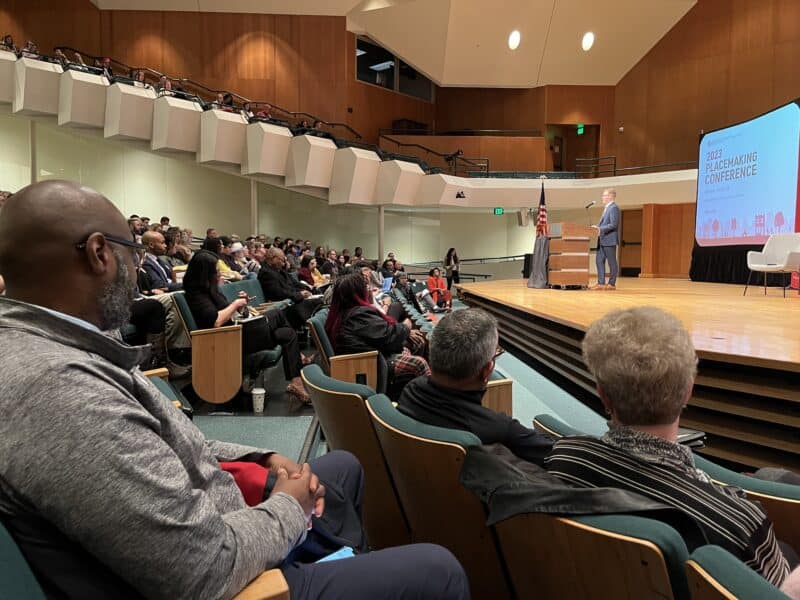
OU IQC Director Shane Hampton opened the conference. Dwayne Bright from Kansas City, Kansas, is seated to the left.
Rural + Urban connections
I was sitting next to (and really surrounded by) a group from Kansas City, Kansas, who attended to learn more about housing and ideas they could use in their urban neighborhoods. Dwayne Bright is a Fuse Executive Fellow working there. We had some interesting discussions about how rural communities and urban neighborhoods are similar. Both have lost housing and much more over the decades, and many similar ideas will work in both types of communities.
This was not new to me, from conversations with Cheryl Lawson and others about their communities and with you about your rural ones.
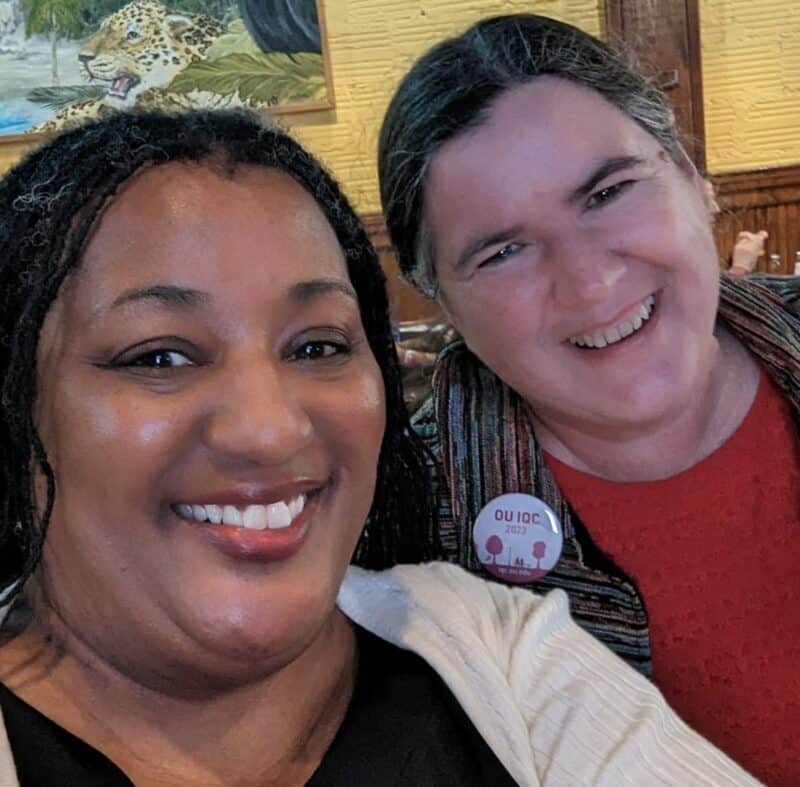
Cheryl Lawson of Tulsa attended the Placemaking Conference after seeing my tweet about it.
Cheryl Lawson is a longtime online community leader and offline placemaker in Tulsa. She created and led the #SMTulsa Conference for 10 years, and I was honored to be involved each year. Cheryl has welcomed me into the SMTulsa family, where I have learned a great deal about community building and social media.
Through SMTulsa friends like Cheryl and Carlo Moreno, I’ve learned a lot about the terrible history of the Tulsa Race Massacre, as well as Tulsa’s Greenwood District past and present, the North Tulsa neighborhood of today, and Oklahoma’s historic All Black Towns. I’m no expert, but this knowledge has definitely broadened my perspectives.
Read Cheryl’s event report at Medium.
Survey of Rural Challenges 2023 results
To find out what rural people felt were their biggest challenges, SaveYour.Town and SmallBizSurvival.com surveyed 315 rural people from the US, Canada and Australia between November 2022 and January 2023. The results make up this fifth edition of the Survey of Rural Challenges. Download the PDF Report Survey of Rural Challenges 2023 by debworks Top conclusions […]
To find out what rural people felt were their biggest challenges, SaveYour.Town and SmallBizSurvival.com surveyed 315 rural people from the US, Canada and Australia between November 2022 and January 2023. The results make up this fifth edition of the Survey of Rural Challenges.
Survey of Rural Challenges 2023 by debworks
Top conclusions from the survey
Rural people were twice as likely to say they were optimistic about their communities’ future as negative.
Continuing lack of housing, inactive downtowns and population losses ranked the highest as rural community challenges.
The ongoing lack of workers, support services and usable buildings, stiff competition from online businesses, and marketing ranked the highest as challenges to rural small businesses.
Other preconception-changing results
Defying stereotyped media profiles of poverty, crime and drug abuse as the primary rural challenges, rural people continually ranked these near the bottom as community challenges.
Rural businesses innovate. Far from stuck in their ways and out of date, the most common business assets listed in 2023 were innovative ideas and up-to-date marketing techniques.
Although rural economic development often centers around jobs, it was one of the least-mentioned challenges in this survey. Rural people mentioned available jobs or good jobs as often as mentioning a lack of jobs or low paying jobs.
For all the reports of a lack of small business lending, rural people said usable buildings are harder to find than loans, a continuing trend from previous surveys.
Rural small business owners showed little or no interest in business plan assistance and pitch competitions, yet these types of assistance continue to be commonly offered to rural businesses.
Rural business people were more likely to mention that they needed help with marketing, starting a business, or receiving economic development incentives on par with those offered to recruit out-of-town firms.
Rural community optimism
A new question in 2023 asked respondents “Do you think your community will be better off in 10 years?”
Answers of 1 or 2 were considered negative, and answers of 4 or 5 were considered positive. More than twice as many people gave a positive response (119) than were negative (50) about their communities’ future. Almost as many were positive (119) as were neutral (136).
Nearly all of the survey participants responded to this question, 305 out of 315.
Rural Community Challenges & Assets
Lack of housing, inactive downtowns and population losses continue to rank the highest as rural community challenges. Lack of childcare also ranks in the top 5.
The top five rural community challenges in 2023 were:
- Shortage of good housing
- Downtown is dead
- Not enough volunteers
- Losing young people
- Lack of childcare
More about rural community challenges
Through open-ended responses, participants could enter more detailed answers about their challenges. Out of 177 comments, the most common topics mentioned broke down into these rough categories.
- Attitudes: Poor leadership, sticking with outdated methods and infighting were mentioned by 39% of responses.
- Infrastructure: Empty buildings, a lack of housing or usable commercial buildings, broadband, water, wastewater, transportation featured in 26% of responses.
- Economic opportunity: Lack of funding, lack of services and support for small businesses, and a need for a specific business in the community were mentioned in 26% of answers.
Rural Community Assets
On the open-ended questions, people mentioned their community’s assets in 233 responses.
Natural resources, land, outdoor recreation, location and tourism were the most common assets, mentioned in 64% of responses.
Committed people, volunteers, an engaged community, workforce and effective local leaders were mentioned in 48% of the answers.
Events, arts, education and culture came up in 32% of the comments.
Local businesses, a thriving downtown, the variety of local businesses, business development and agriculture featured in 28% of responses.
Infrastructure, buildings, housing, broadband and technology were considered an asset in 9% of answers.
Healthcare was listed as an asset in 7% of responses.
Small-town Business Challenges & Assets
The lack of workers and difficulties with marketing continue to challenge rural small businesses. Lack of support from government or agencies ranked second. Lack of usable buildings continues to climb in importance, breaking into the top five.
The top five challenges ranked by rural small businesses were:
- Lack of good workers
- Lack of support from agencies, government or organizations
- Need a usable building
- Online competition
- Marketing isn’t working
More about rural business challenges
Across the open-ended questions, people mentioned rural business challenges in 43 responses.
The most common topics mentioned broke down into the following rough categories.
- Small business assistance: 30% mentioned needing business assistance including a lack of competent service providers, support programs, training and technical assistance.
- Customer service challenges were mentioned by 26%.
- Competition: Big box stores and other competition were mentioned in 17% responses.
- Over 20 other issues were mentioned in the 43 responses, indicating a diversity of challenges facing rural small businesses.
Small-town Business Assets
Across the open-ended questions, people shared more about their business’s assets in 112 responses. More than twice as many of these responses listed assets as listed business challenges.
People were the top small business asset. Caring people, loyalty, relationships and engagement came up in 22% of answers. Although the lack of workforce was the most commonly chosen challenge, nine people specifically mentioned their workforce as an asset.
Trying new ideas and new marketing was common. Almost 20% of answers included new ideas the business had tried successfully. Up-to-date marketing techniques were mentioned as assets in 12% of the answers.
Customer service was mentioned positively in 13% of answers. More people mentioned it as an asset (16) than listed it as a challenge (11).
The community was called an asset to their small business in 9% of answers.
The makeup of rural communities
An open-ended question invited participants to tell more about the makeup of their communities.
Race, ethnicity and cultural backgrounds including White, Black, Hispanic or Latino, Native American or Indigenous, Francophone and general diversity were mentioned in 95% of answers.
Age was included in 69% of responses. Two-thirds of those answers mentioned elderly or aging populations specifically.
Income or education levels were mentioned in 35% of responses.
All other groups were mentioned in few answers. People mentioned openness to different groups, challenges or lack of acceptance, and lack of opportunities for differing people. Less than 6% brought up politics.
Charts and more detail in the report
Share this infographic
Click here for the full size infographic
About the survey methodology
The survey was open from November 11, 2023 to January 31, 2023. A total of 315 responses were collected online from subscribers and visitors to SaveYour.Town and SmallBizSurvival.com, from media coverage and cooperating groups that publicized the survey.
Respondents identified themselves as rural by completing the survey, and 206 identified themselves as business owners by responding to the business question. Participants included 295 from the USA, eleven from Canada and six from Australia.
Based on SaveYour.Town customer data, most respondents likely serve as community leaders and officials, work in community and economic development, own their own businesses, work in a community-oriented business or volunteer informally in their community.
Previous surveys and more
Find the previous surveys back through 2015, and more information at https://smallbizsurvival.com/survey-of-rural-challenges.html
Keywords and classification:
- Survey of Rural Challenges
- Rural surveys and polls
- What rural people need and want
- What a small town needs
- Rural people needs and wants
- Rural challenges
- Small town issues
- Urban-rural divide
- Rural policy
- Diversity in rural communities
- Diverse small towns
- Rural assistance programs
For more info contact
Becky McCray becky@smallbizsurvival.com
Deb Brown deb@saveyour.town

